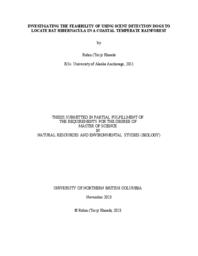Lausen, Cori
Person Preferred Name
Cori Lausen
Related Works
Content type
Digital Document
Description / Synopsis
Little brown bat (Myotis lucifugus) populations have dramatically declined in North America as a result of white-nose syndrome, a fungal pathogen. The identification and protection of hibernacula is important to conservation efforts for the species. Little brown bats in western North America use a greater variety of hibernacula structures than their conspecifics in other portions of the continent, however relatively few have been identified. Existing techniques for locating hibernacula are limited and not conducive to all habitats; new methods are needed. The objectives of my research were to investigate whether a combination of scent detection dogs and game cameras at rocky outcrops could identify entrances to little brown bat hibernacula occurring in the Milieu Souterrain Superficiel (MSS) of Southeast Alaska during summer swarming. Additionally, I described swarming activity at swarming sites and hibernacula in Southeast Alaska to determine if specific behaviours during swarming were likely to be predictive of hibernation at that site. Using trained scent-detection dogs and game cameras, I identified six new hibernacula along ridges where bats were known to overwinter. Using cameras, I found that sites where bats were observed making u-turn behaviours were later used for hibernation, and that sites where circling and crawling behaviours were observed were less likely to be used as hibernacula. When bats were recorded at sites during the swarming period was also related to whether sites were used over winter; sites with more videos recorded during 26 August ̵ 8 September were more likely to be used as hibernacula. I conclude that it is possible to use scent detection dogs and game cameras at crevices during summer swarming to identify hibernacula in the MSS. Surveying with dogs will be most effective in areas with accessible habitat with recent bat use. A multipronged approach incorporating multiple tools, such as using radiotelemetry to broadly identify areas to search or using acoustic detectors to monitor bat activity levels prior to surveying, may increase the efficacy of the method.
Origin Information
Content type
Digital Document
Description / Synopsis
Many animals spend a considerable amount of time within a shelter, and shelter availability can influence the distribution, abundance, and diversity of animal populations. Shelters used during winter, when ambient temperatures are low (< 0°C), must provide animals with adequate protection to survive through months of adverse conditions. For bats, shelters (roosts) used during winter must also provide microclimates that support energetic requirements for hibernation. Silver-haired bats (Lasionycteris noctivagans) are a tree-roosting species that are migratory throughout much of their range. In parts of northwestern North America, however, they may hibernate locally. Hibernation sites (hibernacula) in regions where winter temperatures are below freezing are typically caves, underground mines, or rock crevice features, as these protect bats from cold temperatures and provide a humid environment that prevents dehydration. In a forested area near Beasley in southern British Columbia, silver-haired bats use an abandoned mine, rock crevices, and trees as roosts during winter. The use of trees as roosts during winter in cold regions (average temperatures < 0°C) is poorly understood. I sought to investigate the winter ecology of tree-roosting silver-haired bats in southern British Columbia. In Chapter 2, I described the characteristics of trees used as hibernacula by silver-haired bats. I hypothesize that bats select winter roost trees non-randomly, and differently across seasons. In Chapter 3, I investigated microclimates and torpor patterns inside silver-haired bat mine, tree, and rock crevice hibernacula. I hypothesize that microclimates vary among winter roost types, and because of these differences, torpor, arousal and movement patterns will differ among tree, rock crevice and mine winter roosts. A majority (66.7%, n = 22) of silver-haired bats used trees as winter roosts during the study. Winter tree roosts were selected non-randomly, and compared to summer roosts, bats used features that provided insulation, such as, cavities in large-diameter, low-decay trees in areas of low canopy closure. Winter trees roosts were colder but more humid compared to the mine and rock crevice roosts. Bats switched among roosts throughout winter depending on ambient conditions but did not alter torpor patterns among roost types. Bats typically used humid roosts (trees) on drier days, and less humid roosts (mine) on more humid days. Further, bats used the well-insulated mine on colder days, and poorly insulated trees and rock crevice roosts on warmer days. Despite this, bats showed more tolerance for colder roost temperatures than expected, remaining in trees during periods of cold (-9°C) temperatures. I conclude that there may be a trade-off between roost humidity and temperature, with bats using multiple hibernacula to optimize energetic benefits in the context of ambient conditions. Trees are an important part of silver-haired bat winter ecology. The use of trees as hibernacula needs to be better understood to inform forest management decisions that better support silver-haired bat conservation by protecting important winter roosts
Origin Information


